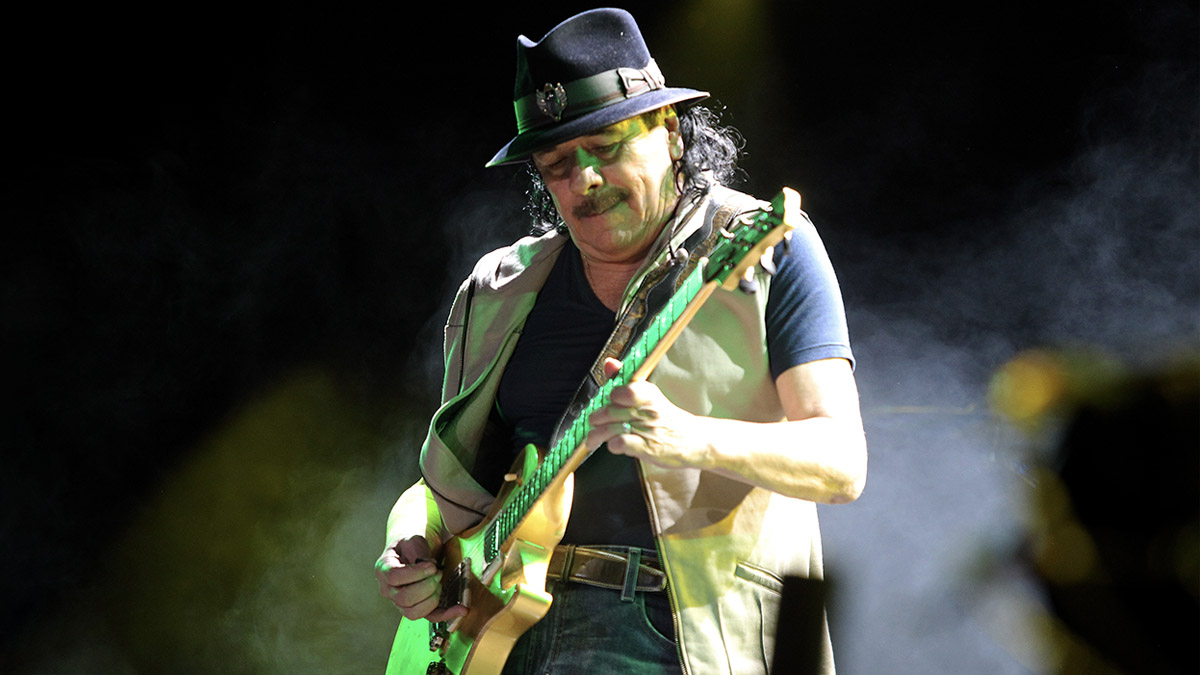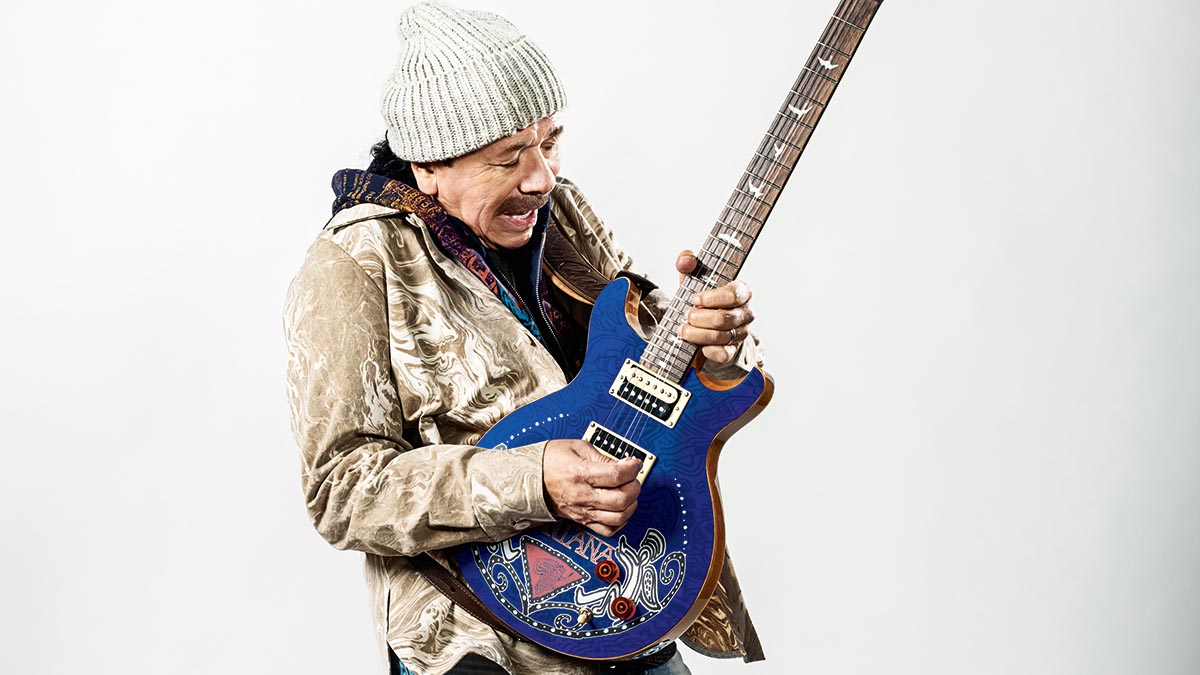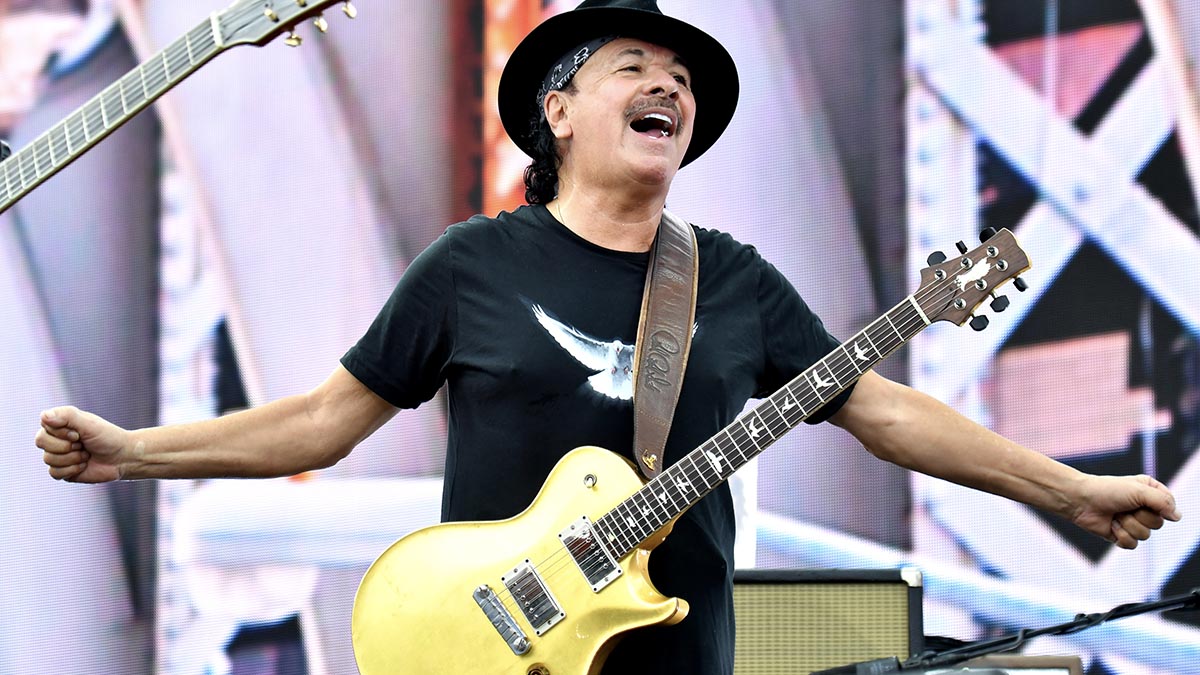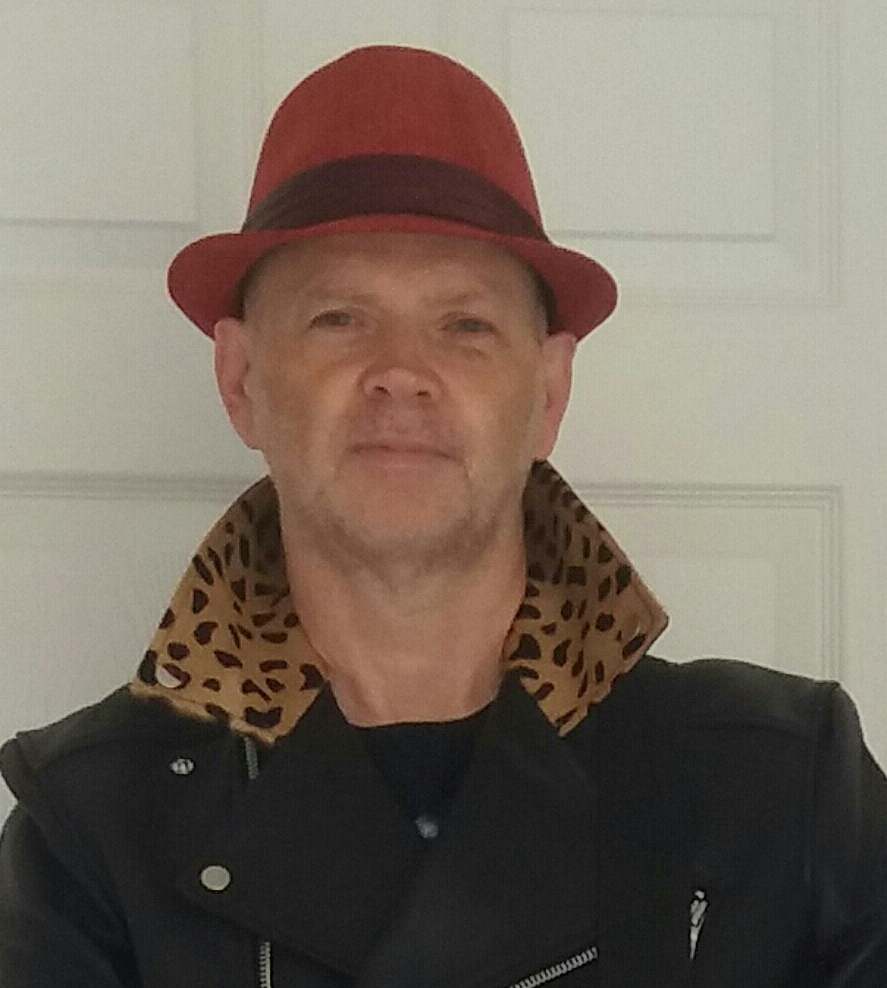Carlos Santana: “I’ve always really loved B.B. King and Peter Green, and I wanted to combine that with Tito Puente and Mongo Santamaria”
The guitar legend reflects on the making of his star-studded new album, Blessings and Miracles, and explains that for an artist, the universe can be the wind beneath your wings

Carlos Santana is one of a handful of guitarists whose style is so instantly recognizable that – if you hear just a handful of notes anywhere on the neck – there’s no doubt who’s playing them.
He released his debut album, Santana, in 1969 and famously played at the Woodstock festival (where, some argue, he stole the show) that August. The following year, he cemented his rep with Abraxas, a now-classic album that stars three of his most popular songs – Oye Como Va, Samba Pa Ti and his cover of Fleetwood Mac’s Black Magic Woman – all of which have been staples of rock radio for the past 50-plus years.
As successful as Santana already was, however, his career shot to another level with the release of the star-studded Supernatural in 1999. Its worldwide crossover hit, Smooth, turned him into a household name.
“It was certainly an experience to have that level of exposure,” he says. “I remember I was in a hotel in L.A., and Jeff Beck was there. He looked at me and said, ‘It must be really something to be Carlos Santana right now, huh?’” [Laughs]
Santana's new album, Blessings and Miracles, is certainly his most commercial album since Supernatural – and it, too, features its share of big-name guest stars, including Kirk Hammett, Chris Stapleton, Rob Thomas and Steve Winwood. It’s packed with radio-friendly, hook-filled tunes that cover the entire gamut of his range, from Hendrix-fired rockers to his patented Latino blues dance tracks such as Rumbalero.
“I’ve always really loved B.B. King and Peter Green, and I wanted to combine that with Tito Puente and Mongo Santamaria,” he says. “To have that Latin feel and underpin it with blues guitar is – for me – the best of both worlds combined, really. It’s a winning combination.”
Santana, a deeply spiritual man, is a strong believer in the powers of the universe and positivism. Taking nothing for granted in his career, the word he most often uses to express his happiness with his life, his art and the new album is “joy”.
Get The Pick Newsletter
All the latest guitar news, interviews, lessons, reviews, deals and more, direct to your inbox!
The new album is called Blessings and Miracles, which is a very spiritual title. You’ve always been spiritual. Are you making a personal statement with this record?
“Yes. It’s about 'frequency' – the frequency that the shamans around the world understand, also the aborigines, the American Indians, shamans from Siberia, every kind of shaman. For clarity, someone like Eric Clapton, Jeff Beck, Jimmy Page or myself, the thing with music for us is that it is a holy experience.
“You can tell by the title of the songs that we deeply believe. It’s not show business or entertainment, with all due respect to that. This is like a mystical, meditative music to heal a twisted, crooked, infected world. I feel like we’re almost 'spirit doctors.'
“I wake up to bring hope and courage to people, and I also wake up to receive the same thing. I love to hear all the music that I love, which is pure inspiration and joy. With this pandemic, people have become really thirsty for integrity and righteousness. There’s a lot of deception and corruption in the world.
“You need to go inside your heart to hear what’s really real in these times. It seems like TV news is only promoting fear and separation, and I find it to be very boring. I’m excited to hear the sound of birds, children and the stars at night twinkling. What I learned from this epidemic is to go even deeper into my heart.
How easy was it to put the album together, given COVID restrictions, etc.?
“There is someone who orchestrates everything that happens and guides me to the incredible artists who come and partake with me. I think this has been true of my whole career. I’m one of the few artists, for example, who has worked with all three of the Kings – B.B., Albert and Freddie.
“Then you think of the artists from other genres, such as Paco de Lucia, John McLaughlin, Eric Clapton. It’s like it’s being orchestrated, and I just have to show up. So many people who I really admire! These days it is possible with technology to record with someone who can be on the other side of the world. That doesn’t really matter, because I feel like we are sharing some kind of frequency in the moment.”
It is a wonderful, delightful experience to share the record with my family. I get so much extra joy from making music with my family – it is a very special experience
Your career has spanned many decades, and therefore many changes in technology. Do you feel analog was always a better fit for music that’s as organic as yours?
“The principal is still the same, you know? You can cook with a microwave or a stove, and as long as the ingredients are right, it will taste good. The ultimate result is that it has to be delicious. [Laughs]”
You have your wife, Cindy, on drums, and two of your children – Salvador and Stella – also appear on the album. I imagine it’s pretty special to be able to share the creative process with them.
“It is a wonderful, delightful experience to share the record with my family. Stella sings Breathing Underwater beautifully, and Salvador adds so much to Rumbalero. It’s like whipped cream on top. [Laughs] I get so much extra joy from making music with my family – it is a very special experience.”
Are you always creating and stockpiling songs, or do you prefer to work to a deadline when you know you have a project coming up?
“I believe it’s important to constantly expand, expand and expand –by always creating and challenging myself. I’m looking forward, at the moment, to creating an album that is purely instrumental. Nothing will be geared up to radio or radio-friendly commerciality.
“In a way, I’m picturing something like a soundtrack, perhaps in the vein of an Ennio Morricone score for an imaginary spaghetti western – The Good, the Bad and the Ugly, that kind of thing, you know?
“I talked about this with Eric Clapton and Derek Trucks, and that is something we will be working on together in the near future. We aren’t going to be concerned about songs; it will be more about moods.”
It’s interesting that your next album won’t be focused on radio airplay – since your new one is packed with commercial songs that are almost guaranteed airplay. It plays out like a collection of hit singles.
“Thank you for saying that. It is a blessing to be able to work with writers like Diane Warren and great singers such as Stevie Winwood. It’s a joy, a real joy. It’s so stimulating. It is wonderful to be able to present yourself as a multi-dimensional person that can cover everything pretty much from A to Z in music.
“I can’t wait for people to hear what an amazing job my brother Stevie Winwood does on Whiter Shade of Pale. He also plays the organ on it, but what we did differently from the original is that there is a hint of African about it, and it is a very, very sexy version. [Laughs]”

What made you choose that song to cover?
“I just heard it in my head, you know? I was in Hyde Park in London with Eric Clapton and Stevie and I just heard it. I told Stevie about it to see if he had eyes to do something about it. I described what I was hearing and he heard what I heard; he understood exactly what I was trying to achieve.”
America for Sale – which features Metallica’s Kirk Hammett and Death Angel’s Mark Osegueda – is a full-on burst of blistering rock.
“It worked out by grace again. I think there is some kind of divine intelligence orchestrating for me to participate with these incredible artists. All I have to do is take a deep breath, be honest and sincere and play music that complements the artist I’m playing with. We really tried to push ourselves to the outer limits with the solos on that song, though.”
I think there is some kind of divine intelligence orchestrating for me to participate with these incredible artists
Peace Power – featuring Living Colour’s Corey Glover on vocals – will probably be a standout track for a lot of listeners. It channels the spirit of Jimi Hendrix and, again, showcases the high-energy rock side of your playing.
“You’re right; there is definitely something of the spirit of Jimi on that song, and Corey did a fantastic job. It was originally going to be Lenny Kravitz, but he couldn’t do it because of COVID. He was on an island and so was I, actually, in Hawaii, so we couldn’t connect. But my wife Cindy suggested I call Corey; of course, things turned out brilliantly in the end.”
The album covers a lot of different styles, and I guess rock fans will connect with America, Peace Power and Mother Yes, which also has the feel of Hendrix in the groove. In fact, the short piece at the end of the album, Ghost of Future Pull II, feels like Jimi’s Third Stone from the Sun.
“I’d love to do something in the future that is all rock-type material. I love rock music, you know? One of my favorite bands is AC/DC, and I am a huge Led Zeppelin fan, so I am really hoping I can do a pure rock album at some point.
“I know as well that there is a huge appetite from fans for heavy rock songs with a lot of guitar to the fore, and that is something I would really enjoy doing – as a change of pace from what people perhaps expect me to do. I think people are thirsty for energy and high vibrations where people can ward off darkness and insecurities.”
I know you mentioned the notion of a soundtrack-like album coming up next. The track Santana Celebration sounds very much like a piece from a movie. It actually reminded me of Lalo Schifrin’s work, particularly, oddly enough, Enter the Dragon.
“You are absolutely correct. I love Lalo’s work; I like music that is very visual and multi-dimensional. I’d love to do an actual soundtrack in the future. I’m open to offers. [Laughs]”

On Joy, you have a huge tone on the opening notes. That lulls us into thinking more of the same is about to follow – but you suddenly shift into a reggae groove that takes the listener by surprise. Although, given your love of the genre, and Bob Marley in particular, maybe we shouldn’t be surprised?
“Yes, I love Bob’s music. Joy sums up everything about working on the record, and working with Chris Stapleton on vocals was a particularly joyful experience. We had the track partly prepared, but without lyrics and a vocalist, and we were discussing who could bring something special to the vocal.
“When I did my last album, Africa Speaks, in 2019, I didn’t really care about having a hit single, but this time I wanted to get the songs on the radio. I asked my producer, who has really got his finger on the pulse of commercial radio at the moment, who would be cool for us to work with.
We all have preferences in the instruments we choose, but in all honesty, you are the sound
“A few names were thrown out, and then Chris was suggested. That seemed to be the very thing I was looking for. We called up his manager to see if he would be interested in taking part and writing the song with us.
“Again, whenever you ask the universe, God, Jesus or whatever you want to call it will answer you and give you what you want. The universe will comply with your request. If you ask, you’re open, and if you’re ready then things will come to you. It’s not chance or luck or fortune; it’s grace. Grace is a very tangible component or element that can work for you and with you.”
Move reunites you with Rob Thomas, who sang on Smooth in 1999. Was that a conscious effort to reproduce some of that feel and magic?
“Pretty much like the Supernatural album, there was an element of putting different bits and pieces and different artists together. At the time that Move landed on my lap, Rob called me up and asked me to see if I thought I could put some guitar on the track.
“As soon as I heard it, I thought, ‘Oh, yes.’ [Laughs] I heard the Smooth connection right away; it seemed to be such a natural, logical progression from that song to Move. I like to say it’s a song about awakening your molecules, igniting and activating yourself.”
When you’re collaborating with other artists, is there a lot of give and take, or will you have some fixed ideas that you might insist upon?
“Collaboration is pure joy for me. I like to just let things unfold in front of me and see where the spirit of the music takes me.
“Once I’m ready to play, everything is always done in one take; I’m always so present in the moment of what I am playing that I can express everything in that one take. I learned that from so many great artists – nail it on the first take and make sure that’s the one.”
Much like B.B. King, you have such an instantly identifiable style and sound. What’s the secret to finding your own style on guitar?
“If there is such a thing as a secret, I guess it would be to not think about what you are doing. Emotion, passion and feelings are what we all have, and if you keep yourself open, you can let these things express themselves through your playing. I grew up on Peter Green and B.B. King and, of course, those two players have very different individual styles.
“The essence of that is that they let themselves honestly express what they were feeling through their instrument. B.B. King was originally the template for how I wanted to create my voice on the guitar, but after that period that players go through when they try to sound like their heroes, they have to find out who they are. I am very grateful that I’ve found something that is uniquely my own style.”
When you’re playing around the house or whatever, what kind of things do you play? Do you ever explore styles you’re not familiar with?
“When I was preparing to record this album, I spent a lot of time listening to Lady Soul lines, the horn parts, the keyboard parts, I learned every one of them. Eric Clapton does an incredible solo on Good to Me As I Am to You.
“If you want to learn how to play the guitar and find something new, maybe make it sound like a voice, take your fingers for a walk with Aretha Franklin. [Laughs] I really just focus on what I’m going to need for the stage or the studio when I’m playing at home, I guess.”
You’ve been a PRS Guitars player for many years, with a number of signature models. Are the PRS guitars you play off-the-shelf instruments, or are they customized?
“You know, not so long ago I was actually playing a Stratocaster, but I got that out of my system and I’m back now with Paul Reed Smith. I use some of the signature guitars. They maybe tweak them a little here or there for my preferences, but they are basically the same guitar.
“Someone like Eric or Jeff or Stevie Ray, we can grab any guitar and we will sound good. It’s you – it’s not even the guitar anymore. I don’t deceive myself into thinking, ‘Without this guitar, I won’t sound good.’ It’s you – you are the gift God gave you. We all have preferences in the instruments we choose, but in all honesty, you are the sound.”
Amp-wise, is it still Mesa/Boogie for you?
“I research sound all the time. I’ve been using Dumble amplifiers as well, plus Paul Reed Smith has just designed a new amplifier. I tried it last week and it sounds really, really good. Like an artist, you’re always looking for different brushes and pencils.
“Expand and expand, don’t be predictable, always find ways to make something new happen, you know? I’ve never been much of an effects fan, mainly just the wah. Believe it or not, I was in an elevator with Miles Davis and he asked me [does a spot-on impression of Davis’ husky voice], ‘Hey, you got a wah-wah pedal?’ I said, ‘No.’ And he says, ‘I got one for my trumpet. You’ve got to get yourself a freakin’ wah-wah pedal.’ I laughed and said, ‘OK, Miles. That was what got me to buy my first wah pedal.”
You compiled Sacred Sources, Vol. 1: Live Forever about 30 years ago, based on your archive of live recordings of SRV, Hendrix, Marley and Marvin Gaye. You said at the time that you were an avid collector of live recordings. Are you still as passionate about it?
“I am. I’m always looking for performances by Marvin Gaye, Bob Marley and particularly John Coltrane and Miles Davis in a live setting. It is easier to track down lost recordings with the aid of the internet than it used to be way back then, though. What I love about the internet is that when I wake up at 3 in the morning and can’t get to sleep, I can go hunting for music from Africa, or the people that I love, or whatever.”
Samba Pa Ti seems to be played on radio stations across the world nearly every day. I wonder, after 50 years, when you hear it, do you hear parts you wish you’d done differently?
“Your intuition is incredible, because I was just thinking about that song a short while ago, because it was the first song I ever heard on the radio by Santana, and it was like looking at myself as another person.
It’s also cool to know that so many women got pregnant to the soundtrack of Samba Pa Ti. What can I tell you? It never gets old
“I was remembering a conversation I had with Eric Clapton when we were playing with Earth Wind & Fire in ’75. He said, ‘Hey, Carlos. When you did Samba Pa Ti, did it just come out all at once as one continuous piece of music?” And I said, ‘Yeah, Eric.’ [Laughs] I did record it in one take without any overdubs or anything, and to hear Eric Clapton express admiration was a very special moment.
“It’s also cool to know that so many women got pregnant to the soundtrack of that song. [Laughs] What can I tell you? It never gets old. When a song comes to you as fully formed as that, it makes you believe there is a higher power out there that is giving us the music.”
Given the many years you’ve been playing, have you ever experienced any painful hand problems? I know quite a few of your contemporaries have had some struggles in recent years, including Robby Krieger and John McLaughlin.
“No, not at all. By the grace of God, I don’t have any kind of ‘itis.’ No arthritis, tendonitis, meningitis. ‘Itis’ and Santana don’t get along, so I just dismiss them. [Laughs] I say go bother somebody else – don’t bother me!”
- Blessings and Miracles is out now via Starfaith.
Mark is a freelance writer with particular expertise in the fields of ‘70s glam, punk, rockabilly and classic ‘50s rock and roll. He sings and plays guitar in his own musical project, Star Studded Sham, which has been described as sounding like the hits of T. Rex and Slade as played by Johnny Thunders. He had several indie hits with his band, Private Sector and has worked with a host of UK punk luminaries. Mark also presents themed radio shows for Generating Steam Heat. He has just completed his first novel, The Bulletproof Truth, and is currently working on the sequel.
“My guitar tech ran in and said, ‘Hey, you want to meet Pete?’ I was too scared”: The Smithereens’ love affair with The Who goes way back – yet when guitarist Jim Babjak got the chance to meet Pete Townshend, he turned it down
“Every tour was the best I could have done. It was only after that I would listen to more Grateful Dead and realize I hadn’t come close”: John Mayer and Bob Weir reflect on 10 years of Dead & Company – and why the Sphere forced them to reassess everything


![John Mayer and Bob Weir [left] of Dead & Company photographed against a grey background. Mayer wears a blue overshirt and has his signature Silver Sky on his shoulder. Weir wears grey and a bolo tie.](https://cdn.mos.cms.futurecdn.net/C6niSAybzVCHoYcpJ8ZZgE.jpg)

![A black-and-white action shot of Sergeant Thunderhoof perform live: [from left] Mark Sayer, Dan Flitcroft, Jim Camp and Josh Gallop](https://cdn.mos.cms.futurecdn.net/am3UhJbsxAE239XRRZ8zC8.jpg)






